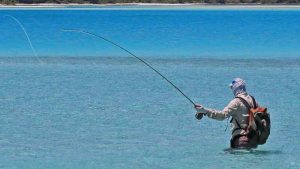 Fly fishing in Florida can be a rewarding and exciting experience. The state offers diverse fishing opportunities, from freshwater lakes and rivers to saltwater flats and coastal areas. Here’s a general guide on how to fly fish in Florida:
Fly fishing in Florida can be a rewarding and exciting experience. The state offers diverse fishing opportunities, from freshwater lakes and rivers to saltwater flats and coastal areas. Here’s a general guide on how to fly fish in Florida:
-
Equipment:
- Fly Rod: Choose a versatile fly rod suitable for the species you want to target. For freshwater fishing, a 5 to 7-weight rod is generally suitable, while for saltwater, a 7 to 10-weight rod is recommended.
- Fly Reel: Ensure your reel matches the rod weight and has a reliable drag system.
- Fly Line: Select a weight-forward floating line for most situations, but consider using sinking or intermediate lines for specific conditions.
- Leaders and Tippets: Use tapered leaders between 7.5 to 9 feet in length, with corresponding tippet sizes based on the target species and fishing conditions.
- Flies: Research and acquire flies that match the local baitfish, insects, or other prevalent food sources. Popular fly patterns for Florida include Clouser Minnows, shrimp imitations, crab patterns, and topwater poppers.
-
Choose Your Fishing Destination:
- Freshwater: Florida boasts numerous freshwater fishing opportunities, including lakes, rivers, and springs. Popular destinations include the Everglades, Lake Okeechobee, and various rivers like the St. Johns, Withlacoochee, and Suwannee.
- Saltwater: Coastal areas, flats, and backcountry provide excellent saltwater fly fishing. The Florida Keys, Mosquito Lagoon, Tampa Bay, and Charlotte Harbor are renowned spots for saltwater fly fishing.
-
Research Local Regulations:
- Check the Florida Fish and Wildlife Conservation Commission (FWC) website for fishing regulations, license requirements, and any specific rules or restrictions for the area you plan to fish. Ensure you have the appropriate fishing license for freshwater or saltwater fishing.
-
Learn Fly Casting Techniques:
- Practice your fly casting techniques before heading out to the water. Focus on accuracy, distance, and presentation. You can find online tutorials or consider taking lessons from a certified fly casting instructor.
-
Understand the Fishing Season and Target Species:
- Florida’s fishing season can vary depending on the species and location. Research the best times to target your desired fish species. Common species targeted in Florida include largemouth bass, snook, redfish, tarpon, bonefish, and permit.
-
Be Aware of Tides and Weather:
- Tides play a crucial role in saltwater fly fishing. Learn how tides affect fish behavior and feeding patterns. Additionally, keep an eye on weather conditions and avoid fishing during storms or unsafe conditions.
-
Respect the Environment:
- Practice catch and release to preserve fish populations.
- Be mindful of the ecosystem and avoid damaging seagrass beds, coral reefs, or other sensitive habitats.
- Dispose of trash properly and leave the fishing area as you found it.
Remember, local knowledge from experienced anglers and guides can be invaluable for finding the best spots and techniques for fly fishing in Florida. Consider hiring a local guide, especially if you’re new to the area or targeting specific species.














